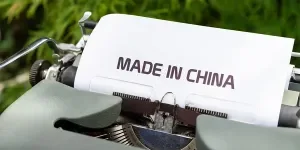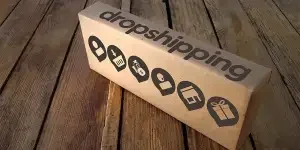Having a feasible product idea can be exciting. So, it’s normal to get ahead of yourself and imagine the success you could achieve.
But, like in any other business, product development requires careful planning to succeed. From ideation to finished product, it consists of stages that ensure a product’s viability, profitability, and customer acceptance.
If it’s your first time creating products to satisfy customers, it’s important to pay attention to the details to ensure each manufacturing stage is successful. Below, we dissect how exactly you can manufacture your product in 10 steps.
Table of Contents
10 steps to manufacture your products
Summary
10 steps to manufacture your products
Effective product development isn’t just about making something – it’s about strategic alignment. Your product must hit three targets: meet business objectives, satisfy customer needs, and fit seamlessly into the market.
As such, there are 10 key steps to kickstart your product development process.
1. Develop a unique product concept
First, develop the product idea into a marketable concept that differentiates you from competitors.
Around 40% of manufacturers say it takes between six and 12 months to develop a new product, from ideation to sales, so patience is crucial. Start with market research to ensure there’s a need for your product in your target market. This will ensure product-market fit in the long run.
Ask questions like:
- Does your product meet a need or solve a problem?
- Are there other products that already fulfill the need?
- How does your product differ from others in the market?
If your answers to these questions are encouraging, proceed to the next stage of the manufacturing process.
2. Design a prototype
After building a product concept, draw a design. It should be as accurate as possible since it’ll be the basis of your prototype.
This design allows you to determine the feasibility of your idea and fix flaws. Your design can be digital or physical, which can be expensive. Use the following tools for your design:
- Drawings
- 3D modeling software
- Videos and pictures as references
- Hiring freelance product designers (Fiverr, Upwork, and Freelancer)
- Using written descriptions
A product development consultant might be helpful, especially if it is your first time navigating the manufacturing process. A consultant can help you to research, develop, and launch your product. They’ll also provide industry insights and cost-saving tips in your production process.
If your budget is too small to hire a consultant, consider asking for help from someone in your network who has previously manufactured products. Mentorship is vital to growing your business, so don’t hesitate to ask friends and associates for help.
3. Prepare a business plan
After establishing whether your product idea is attainable, develop a business plan. It’ll help you understand your costs, competition, and target market. It’ll also help you set realistic goals and monitor your progress.
Let’s say you have an idea for a bean-to-bar craft chocolate company with direct sourcing to retail. You’ll need a direct cocoa bean supplier, a master chocolatier as well as a business plan to attract external investment.
This business plan should include your:
- Unique selling proposition (what makes you different from other chocolate factories?)
- Business model
- Sales and marketing strategy
- Sales forecast
- Projected growth
Your business plan should also include how you plan to finance your start-up costs, monthly operating expenses, and profit targets. Answering these questions will show potential investors the value of the product idea.
4. Attain funding
You can use your business plan to find sources that’ll invest in you. It might be helpful when applying for bank loans — or, alternatively, crowdfunding your business.
One of the benefits of crowdfunding is that anyone can do it. It allows businesses to raise money from investors online. Crowdfunding platforms like Kickstarter, Indiegogo, and Patreon are great for your campaign. Your crowdfunding campaign title should be clear and concise so people can easily understand your product.
For example, GearLand, an innovative outdoor merchandise company, clearly explained in their pitch to customers how their hidden anti-theft compartment can transform into five different types of bags. The title of their campaign is also catchy, helping to pique readers’ curiosity.
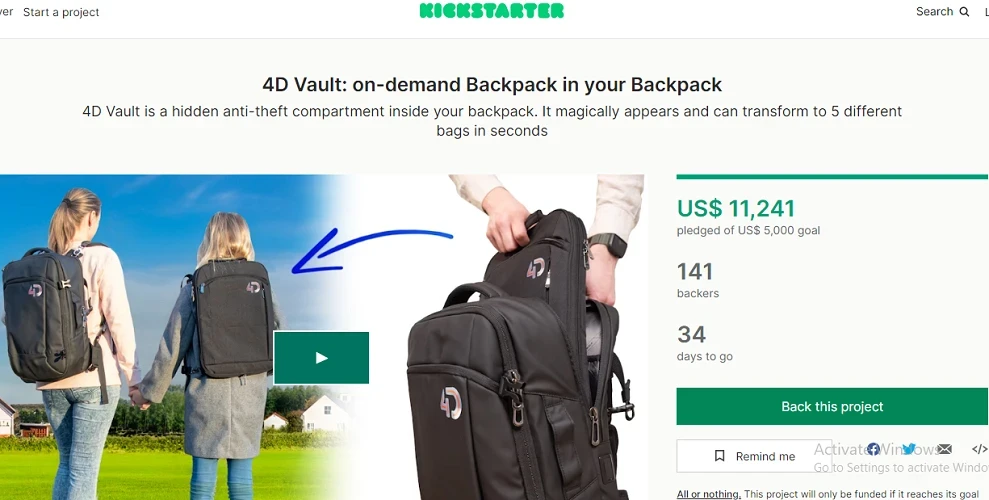
Additionally, if you create a pitch video, try to humanize it via a voiceover to create a personal connection. Also, make a case for your idea and showcase some of your prototype’s features or designs to potential investors.
For example, an entrepreneur, Bianca Wittenberg, pitched her idea – a firefighting device, the Firefighter1 – on the entrepreneur reality TV show Shark Tank.
The idea was that since many homes have pools, why not use the water to fight fire outbreaks before firefighters arrive? She explained how the device could pump 80 gallons per minute, ultimately securing funding.
Remember to also promote your campaign through your email list, social media, blogs, or forums.
5. Find reputable manufacturers
Once you have funding, find the best manufacturer to help make your vision come true.
Do they have good reviews? What about a business license? Also, ensure they have a reliable production line. You can find manufacturers on platforms like Alibaba.com. Just search for the products you want to manufacture.
For example, if you want to manufacture soap, a quick search will present thousands of soaps from suppliers/manufacturers.
Click on “Contact supplier” or “Chat now” to see if they can manufacture soaps according to your specifications.
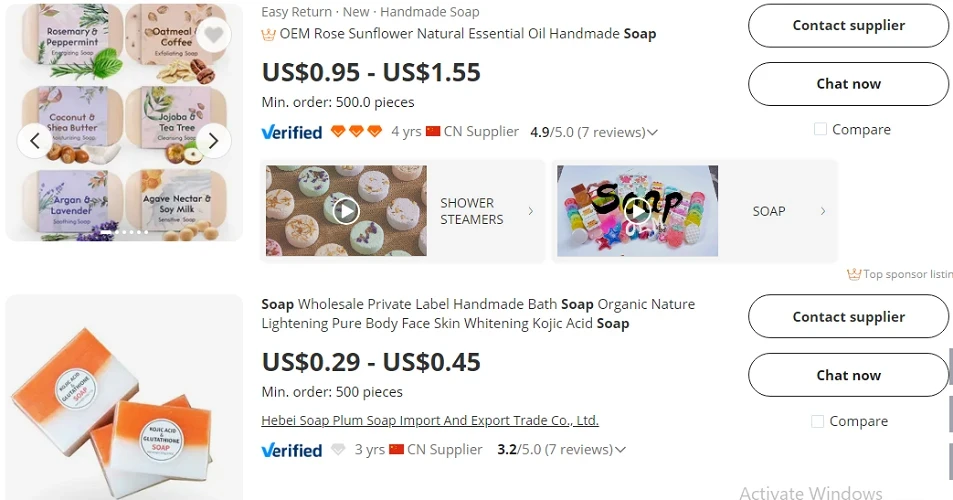
Create a manufacturer specifications document stating the details manufacturers will need to create your products. Present this to them as you shop for manufacturers so they’ll understand the scope of your project and determine if they can accomplish it.
Ask them the following questions to ensure there’s a fit:
- How quickly can they produce and ship your products?
- What’s their manufacturing cost?
- How much do they charge for shipping and handling?
- What carriers do they use?
- What are their minimum order quantities?
Your ability to find the right manufacturer can make or break your company, so do your research well.
6. Request quotations from multiple manufacturers
Now that you have a list of reliable manufacturers, start asking for quotes, i.e. price estimates based on what you need that manufacturers give you before you commit to patronizing them.
You can do this through a Request for Quotation (RFQ) on Alibaba.com. RFQs are a document that B2B buyers use when they want to negotiate with vendors about products they’re interested in.
Here, you can invite open bidding by submitting an RFQ instead of contacting suppliers/manufacturers individually, as we explained earlier. Go to rfq.alibaba.com, and you’ll see a form like this:
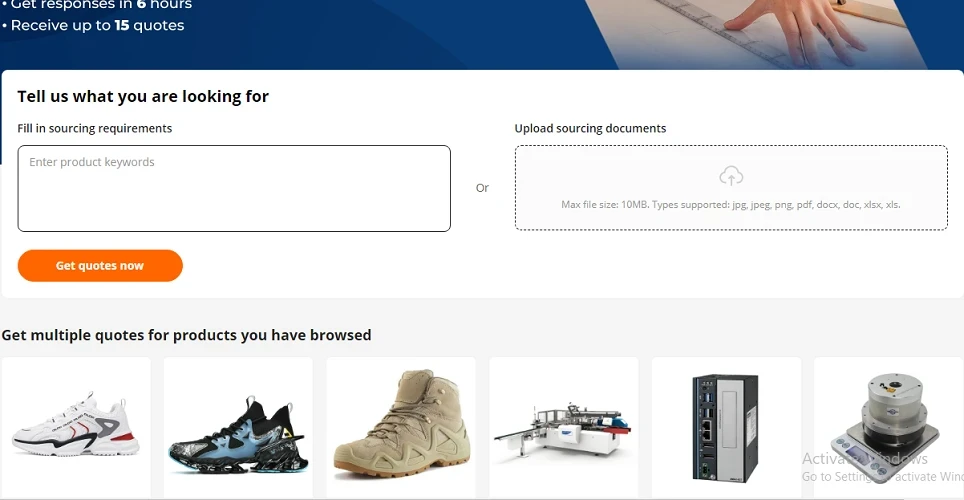
As you see in the image above, you can get quotes for products you’ve browsed previously.
When submitting your quotes, be clear about what you want from the manufacturers. There’s a space where you can upload documents, so include detailed images of your prototype, 3D renderings, and raw materials information.
After you submit your RFQ, Alibaba reviews it before opening the floor to manufacturers for quotations. Alibaba also screens these quotations for authenticity before you receive them. Once you receive them, you can begin negotiating.
7. Order samples
Specify your best options based on which manufacturers’ quotes fit your budget. Reach out to them and request for samples. This way, you’ll ensure the final product is what you want.
Additionally, pick at least two manufacturing companies and order a physical product prototype from each to compare them. Order samples through email addresses they provide in their price quotations.
Alternatively, when you do product searches, as we discussed earlier, clicking on the ones that match your requirements will take you to the product details page. You’ll see ”order sample” in the page’s right corner:
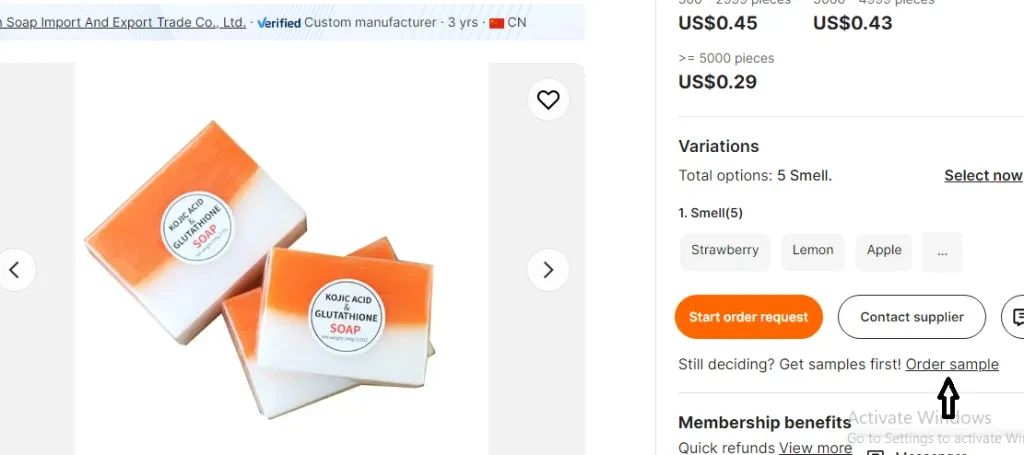
You’ll probably want to refine the sample you select, so don’t be shy about giving honest feedback. This ensures the final result is a quality product.
8. Set your terms
Once you’ve chosen a manufacturer, and tested and finalized your product sample, negotiate details related to payment terms, logistics, and order quantities.
If you ask for payment terms during negotiations with manufacturers on Alibaba, you may get 70/30 payment terms. This means you can pay 70% upfront and 30% after receiving the goods.
Moreover, if you don’t want to put a budgetary strain on your business, you might want to spread payment over a period to free up money for other expenses. Consider negotiating a prolonged payment of the final installment (e.g. within 60 days) after receiving the goods.
As you build a trust-based relationship over time, you could move to more convenient payment terms.
Also, you’ll need to negotiate minimum order quantities with the manufacturer. Their minimum order might require a lot of units for your first order, but try to reach a mutually beneficial agreement.
Note that Alibaba.com manufacturers are more likely to give you discounts if you want to buy in large quantities. If you’re a new business, search for manufacturers willing to work with smaller businesses like yours and grow with you.
Finally, whether your manufacturer will supply you directly or use a third-party carrier, discuss logistics. Request a timeline of when your products will arrive so you can make plans and hold carriers/manufacturers accountable.
9. Validate your product
Before the product launch, validating your new product among your target audience is crucial.
This will allow you to discover how your target market will receive your product when you launch it. It will also help you identify ways for product improvement and refine your marketing strategy.
A quick way to validate your product is through social media influencers in your product niche. You can send product samples to them to create unboxing videos, asking their followers for their opinions.
For example, OnePlus, a consumer electronics company, collaborated with Lauri, a YouTube influencer, to review the OnePlus 10 pro smartphone.
In the unboxing video, Laurie showcased the phone’s screen, memory, and other features that let it run graphics-heavy games smoothly.
This video generated buzz with 585,000 views, while followers shared their thoughts on its features.
10. Build a relationship with your manufacturer
A trust-based relationship with your manufacturer is crucial because it could help to improve your product’s quality. As they get to know you, they’ll be able to proactively anticipate your needs, improving your operational efficiency.
You might also enjoy discounts and other perks new customers don’t get.
Summary
These steps are vital to your product’s success in the market. Each requires careful planning, thorough research, and execution to see your vision come to life.
While product development may seem challenging, following the steps outlined above can help see your product go from idea to real in a matter of months.

